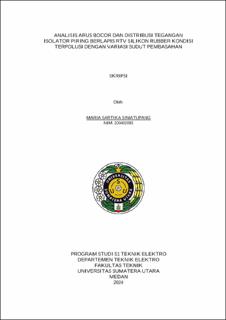| dc.contributor.advisor | Zulkarnain, Hendra | |
| dc.contributor.author | Simatupang, Maria Sartika | |
| dc.date.accessioned | 2025-05-20T03:33:03Z | |
| dc.date.available | 2025-05-20T03:33:03Z | |
| dc.date.issued | 2024 | |
| dc.identifier.uri | https://repositori.usu.ac.id/handle/123456789/103920 | |
| dc.description.abstract | Outdoor insulators can be exposed to accumulated pollution over time, which can significantly reduce their performance. This pollution can become wet due to environmental conditions such as rain or dew. Therefore, it is necessary to test insulators under dry, wet, and polluted conditions. This research focuses on testing the influence of two wetting angles on the performance of disc insulators under various conditions, including those coated with RTV Silicone Rubber and polluted conditions. The aim is to understand the impact of wetting angle on leakage current and voltage distribution of string insulators. The research was conducted with various variations, including types of pollutants (NaCl and CaCO₃), and wetting conditions (∠45° and ∠90°). The test results showed that the highest leakage current occurred on the RTV Silicone Rubber coated insulator contaminated with NaCl at a wetting angle of ∠45°, reaching 578 μA. In the leakage current test, insulators with a wetting angle of ∠90° had a lower final leakage current value compared to insulators with a wetting angle of ∠45°. The higher the pollutant concentration and humidity on the insulator surface, the higher its conductivity, which negatively affects the insulator's performance. In the voltage distribution test, string insulators with a wetting angle variation of ∠45° tended to have a worse uniformity factor compared to string insulators with a wetting angle of ∠90°. The best uniformity factor was recorded on the RTV Silicone Rubber coated insulator contaminated with NaCl with a light weight in dry conditions, reaching 41.76%. The more conductive the pollutant and the presence of a water layer due to wetting, the worse the uniformity factor and the decrease in the insulator's ability to withstand voltage. | en_US |
| dc.language.iso | id | en_US |
| dc.publisher | Universitas Sumatera Utara | en_US |
| dc.subject | Leakage current | en_US |
| dc.subject | voltage distribution | en_US |
| dc.subject | pollutants | en_US |
| dc.subject | RTV Silicone Rubber coating | en_US |
| dc.subject | wetting angle | en_US |
| dc.title | Analisis Arus Bocor dan Distribusi Tegangan Isolator Piring Berlapis RTV Silikon Rubber Kondisi Terpolusi dengan Variasi Sudut Pembasahan | en_US |
| dc.title.alternative | Analysis of Leakage Current and Voltage Distribution of RTV Silicone Rubber-Coated Disc Insulators in Polluted Conditions with Wetting Angle Variations | en_US |
| dc.type | Thesis | en_US |
| dc.identifier.nim | NIM200402093 | |
| dc.identifier.nidn | NIDN0014056104 | |
| dc.identifier.kodeprodi | KODEPRODI20201#Teknik Elektro | |
| dc.description.pages | 116 Pages | en_US |
| dc.description.type | Skripsi Sarjana | en_US |
| dc.subject.sdgs | SDGs 9. Industry Innovation And Infrastructure | en_US |


